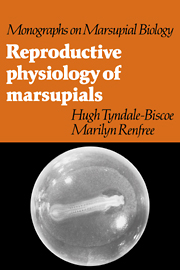Book contents
- Frontmatter
- Contents
- Preface
- 1 Historical introduction
- 2 Breeding biology of marsupials by family
- 3 Sexual differentiation and development
- 4 Male anatomy and spermatogenesis
- 5 The female urogenital tract and oogenesis
- 6 Ovarian function and control
- 7 Pregnancy and parturition
- 8 Lactation
- 9 Neuroendocrine control of seasonal breeding
- 10 Marsupials and the evolution of mammalian reproduction
- References
- Index
8 - Lactation
Published online by Cambridge University Press: 06 January 2010
- Frontmatter
- Contents
- Preface
- 1 Historical introduction
- 2 Breeding biology of marsupials by family
- 3 Sexual differentiation and development
- 4 Male anatomy and spermatogenesis
- 5 The female urogenital tract and oogenesis
- 6 Ovarian function and control
- 7 Pregnancy and parturition
- 8 Lactation
- 9 Neuroendocrine control of seasonal breeding
- 10 Marsupials and the evolution of mammalian reproduction
- References
- Index
Summary
Lactation is a fundamental characteristic of all mammals and has been a major factor in the evolution of mammalian patterns of reproduction (Pond, 1977, 1983). Despite their separate evolution the cellular processes of mammary development appear to be very similar in monotremes, marsupials and eutherians (Bresslau, 1912, 1920; Griffiths et al., 1972; Griffiths et al., 1973; Griffiths, 1978; Cowie, 1984), although the particular lactational strategies of each taxon differ. The young of monotremes and of marsupials are much less developed than the most altricial young of eutherian species and lactation is proportionally much longer. Monotremes lack teats, the galactophores opening on two areolae, and both the mammary glands secrete milk during lactation; among marsupials, however, each young initially has exclusive use of one teat and only the mammary glands associated with these teats lactate. After the first phase of continuous attachment the young begin to release and reattach to the teat and littermates may move from one to another of these teats. During this phase the young may be carried in the pouch or left in a nest, depending on the species (Russell, 1982a).
The composition of the milk of marsupials, unlike that of eutherians, changes substantially through lactation (Green, 1984) and the size of the lactating mammary gland enlarges manyfold, these changes being, presumably, necessary for the considerable growth and development that the young undergoes during this phase of its life.
- Type
- Chapter
- Information
- Reproductive Physiology of Marsupials , pp. 343 - 372Publisher: Cambridge University PressPrint publication year: 1987



